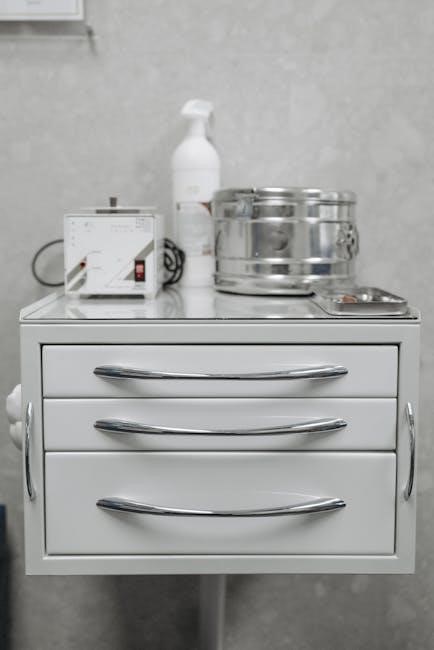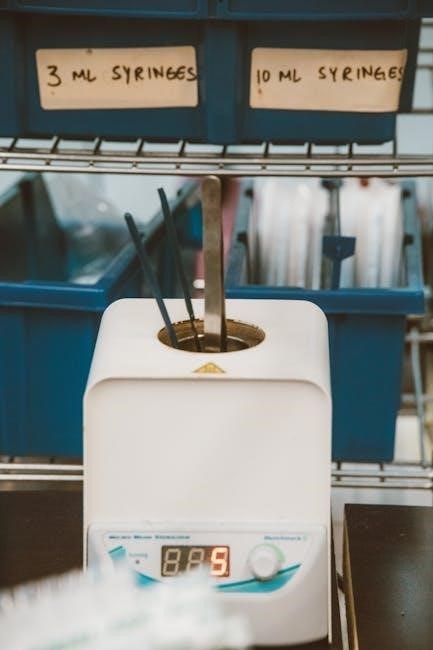
The Tommee Tippee Electric Steam Sterilizer is a popular, efficient solution for sterilizing baby bottles, soothers, and feeding accessories. It ensures items remain sterile for up to 24 hours when unopened.
1.1 Overview of the Product
The Tommee Tippee Electric Steam Sterilizer is a compact, lightweight solution designed for sterilizing baby bottles, soothers, and feeding accessories. It accommodates up to 6 Tommee Tippee bottles and additional items like breast pump parts. The sterilizer uses steam to kill bacteria and ensures contents remain sterile for 24 hours if the lid is unopened. Its user-friendly design includes an 80ml water measure, removable trays, and a drying rack for convenience. The product is easy to clean and maintain, making it a practical choice for parents seeking a reliable sterilization method for their baby essentials.
1.2 Importance of Sterilization for Baby Products
Sterilization is essential for eliminating bacteria, viruses, and germs from baby products, ensuring a safe environment for infants. Babies have developing immune systems, making them vulnerable to infections. Proper sterilization of bottles, soothers, and feeding accessories prevents the growth of harmful microorganisms, reducing the risk of illness. Regular sterilization also maintains the quality and longevity of baby products, ensuring they remain safe for repeated use. This practice is vital for safeguarding a baby’s health and well-being, especially during the first few years of life.

Before Sterilization
Before sterilizing, wash and rinse all bottles and feeding accessories in warm soapy water or a dishwasher (top rack only) to remove milk residues.
2.1 Preparing Bottles and Accessories
Before sterilization, thoroughly wash all bottles, nipples, rings, and lids with warm, soapy water, or place them in a dishwasher on the top rack only. This step ensures the removal of any milk residue, which is crucial for effective sterilization. After washing, rinse items well to eliminate soap traces. Ensure all parts are disassembled, including anti-colic valves, to allow proper cleaning and sterilization. This preparation ensures the sterilizer works efficiently, keeping items safe for your baby.
2.2 Washing Instructions for Bottles and Feeding Accessories
Before sterilization, wash bottles, nipples, and accessories in warm, soapy water or place them in the dishwasher on the top rack. Use a gentle detergent free from fragrances and dyes to avoid residue. Scrub all parts thoroughly, especially nipple openings, using a soft-bristle brush. Rinse everything well to remove soap traces. While washing sanitizes, it doesn’t fully sterilize, making the sterilization process essential. Always follow these steps to ensure items are clean before sterilizing, promoting your baby’s health and safety.

Sterilization Process
The Tommee Tippee Sterilizer uses steam to sanitize bottles and accessories in minutes, ensuring they remain sterile for up to 24 hours when the lid is sealed.
3.1 Assembling the Sterilizer
To assemble the Tommee Tippee Sterilizer, place it on a flat, heat-resistant surface. Pour exactly 80ml of water into the base using the bottle’s built-in measure. Attach the lower tray, ensuring the logo faces forward on the right side. Position bottles neck downwards in the locators, and add accessories like soothers or breast pump parts. Secure the lid tightly to ensure proper steam circulation. Double-check that the water level is correct and no items obstruct the steam vents. Keep the area clear for safe operation.
3.2 Placing Bottles and Accessories in the Sterilizer
Bottles should be placed neck downwards in the sterilizer’s locators, ensuring they fit securely. Accessories like soothers and breast pump parts can be added alongside, but avoid overloading. Use the lower tray for bottles and the upper tray for smaller items. Ensure all parts are properly positioned to allow steam to circulate evenly. The sterilizer can hold up to 6 Tommee Tippee bottles or a mix of fewer bottles and accessories. Make sure the lid is closed tightly to maintain steam and ensure effective sterilization.
3.3 Operating the Sterilizer
Pour exactly 80ml of water into the sterilizer base using the handy measurement on Tommee Tippee bottles. Assemble the lower and upper trays, placing bottles neck downwards and ensuring proper alignment. Close the lid securely to trap steam. Press the power button to start the cycle. The sterilizer uses steam to kill bacteria and keeps items sterile for up to 24 hours if unopened. A countdown timer ensures precise operation, providing peace of mind for parents. Always follow the manufacturer’s guidelines for optimal performance and safety.

Maintenance and Cleaning
Regularly descale and clean the sterilizer to maintain efficiency and hygiene. Remove limescale buildup to ensure optimal performance and prevent damage.
4.1 Cleaning the Sterilizer
Cleaning the Tommee Tippee Sterilizer regularly is essential for maintaining hygiene and performance. Use a soft, damp cloth to wipe down the exterior and interior surfaces. Avoid using abrasive cleaners or scourers, as they may damage the sterilizer. For tougher stains, mix mild detergent with warm water and gently scrub. Rinse thoroughly to remove any soap residue. Allow the sterilizer to dry completely after cleaning to prevent water spots. Regular cleaning ensures optimal functionality and prevents the buildup of milk residue or limescale.
4.2 Descaling the Sterilizer
Descaling your Tommee Tippee Sterilizer is crucial to remove mineral deposits that can build up over time, especially in hard water areas. Regular descaling ensures optimal performance and prevents limescale buildup. Use a descaling solution or white vinegar by following the manufacturer’s instructions. Pour the solution into the water reservoir, run a sterilization cycle, and rinse thoroughly with fresh water to remove any residue. Descaling should be done every 1-3 months, depending on usage and water hardness, to maintain efficiency and extend the sterilizer’s lifespan.

Safety Precautions
Always keep the sterilizer out of children’s reach. Place it on a heat-resistant surface to avoid damage. Regularly descale to maintain performance and follow manufacturer instructions.
5.1 General Safety Tips
Always ensure the sterilizer is placed on a flat, heat-resistant surface and out of children’s reach. Keep the power cord away from hot surfaces or water. Avoid touching hot parts during operation. Regularly check for damage or wear and tear. Use only the recommended amount of water (80ml) to prevent overflow. Descale the sterilizer as instructed to maintain efficiency. Never leave the sterilizer unattended while in use. Ensure children do not handle or play with the sterilizer or its accessories. Always unplug the device when not in use for extended periods.
5.2 Storing the Sterilizer
Store the Tommee Tippee Sterilizer in a cool, dry place away from direct sunlight. After use, ensure it is completely dry before storing to prevent mold growth. Keep it out of reach of children. Store all accessories separately to avoid damage. If storing for an extended period, clean and dry thoroughly. Do not store with the power cord plugged in. This ensures safety and maintains the product’s longevity, keeping it ready for future use without any issues.

Troubleshooting Common Issues

Identify common issues like the sterilizer not turning on, cycles taking too long, or chalky marks. Check power supply, ensure correct water levels, and descale as needed.
6.1 Sterilizer Not Turning On
If the sterilizer fails to turn on, ensure the plug is securely connected to a functioning power outlet. Check that the power button is pressed correctly and not obstructed. Verify that the sterilizer is properly assembled and that no parts are blocking the electrical components. If issues persist, consult the user manual or contact Tommee Tippee customer support for assistance. Always ensure the appliance is used as per the manufacturer’s guidelines to avoid electrical malfunctions.
6.2 Cycle Taking Too Long
If the sterilization cycle is taking longer than expected, check that the correct water amount is used. Excess water can prolong the cycle. Ensure exactly 80ml of water is poured into the sterilizer base, as indicated by the measurement on Tommee Tippee bottles. Verify that the lid is securely closed and no obstructions block steam vents. If issues persist, refer to the user manual or contact customer support for further assistance. Proper water measurement and setup are key to maintaining efficient operation.
6.3 Chalky Marks on Bottles
Chalky marks on bottles indicate the need for descaling the sterilizer; Mineral buildup from water can cause this residue. Regular descaling is essential to prevent limescale deposits. Use a descaling solution as recommended in the cleaning instructions to remove mineral buildup. After descaling, rinse the sterilizer thoroughly and retry the cycle. This maintenance ensures optimal performance and prevents chalky marks on sterilized items. Always follow the manufacturer’s guidelines for descaling frequency and methods to maintain the sterilizer’s efficiency and extend its lifespan. Proper care ensures consistent cleaning results.